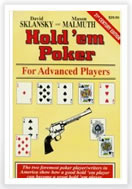 |
Authors: David Sklunsky, Mason Malmuth Publisher: Two Plus Two Pages: 332 Pub. Date: 1999 (3rd edition) Price: $19.77 |
Book Review: Part 1
No-limit Texas Hold’em dominates online play, yet the limit form of hold’em remains a casino staple. Perhaps no better general guide to fixed-limit hold’em success exists than Mason Malmuth and David Sklansky’s Hold’em Poker – For Advanced Players. No longer truly “advanced”, the book remains essential for beginning and intermediate players.
David Sklansky and Mason Malmuth are Las Vegas veterans with decades of fixed-limit hold’em experience, and books such as Hold’em Poker – For Advanced Players and Sklansky’s game-theory exploration, The Theory of Poker, remain among the staple offerings of the firm the two jointly created, Two Plus Two Publishing. The strength of Hold’em Poker – For Advanced Players can be attested to its by longevity; the book was first published in 1988 and has seen two major revisions since, the last in 1999.
Crandall Addington once uttered a famous quote about the difference between fixed-limit (or just “limit”) and no-limit hold’em, which goes, in part: “Limit poker is a science, but no-limit is an art.” This is true, but the best artists’ work is always grounded in sounded science, the same way that any decent oil painting of a landscape nonetheless includes exactly-placed focal lines and perspectives. Poker players who specialize in the no-limit form only are often weaker because of it, failing to understand that a proper grounding in the odds and situations hold’em poker offers makes one a better overall player, and it’s far easier to learn to learn the math and probabilities and standard situations in a limit game. As such, Hold’em Poker – For Advanced Playersis vital reading for allimproving players, not just those who want to play that “boring, old-fashioned limit” stuff. It’s not a greatly written book, with its stiff, awkward phrasings and language that veers toward the pedantic (as a spinsterly schoolmistress might be wont to do), but the material itself is well worth the effort.
Hold’em Poker – For Advanced Players serves up eight basic parts. Part One, “The First Two Cards,” is basically an examination of hand holdings and how to play them from various table positions. Part Two, “Strategic Concepts,” is where the concepts of poker play are first introduced, and the topic headings here are a page-by-page look at what should be part of every poker player’s basic arsenal: semi-bluffing, free cards, slowplaying, check raising, odds and implied odds, bluffing and inducing bluffs, folding in big pots, heads-up versus multiway, raising, and heads-up on fifth street. Novice no-limit players frequently malign the limit game by stating “You can’t bluff in it!” – which is of course false. Limit hold’em offers relatively fewer opportunities for bluffing, but both bluffing and the inducing of others’ bad bluffs, properly executed, are strategic, subtle, profitable plays. Making a semi-bluff after the flop with the intent of taking a free card on the turn is another example of a subtle play no-limit players often miss, with the result that they can no longer control pot sizes and end up all in on nothing more than a draw. The premises behind all these plays are provided here, and each id applicable to far more than just the limit game.